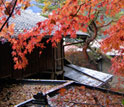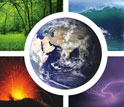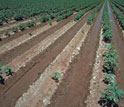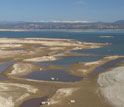News Release 09-184
Life in Transition: National Science Foundation Awards Grants to Study Connections Among Living Systems and Earth's History
How the living world is adapting to and has transformed Earth's climate
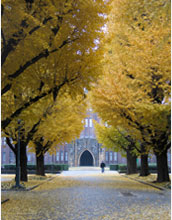
Gingko trees at the University of Tokyo tell a story of changes in when fall arrives each year.
October 5, 2009
This material is available primarily for archival purposes. Telephone numbers or other contact information may be out of date; please see current contact information at media contacts.
What expectations about the direction and magnitude of planetary change can be drawn from an understanding of how the living world has and is shaping Earth's climate?
How is energy transduction managed by living systems of all types and scales and across the diverse range of physical environments found on Earth?
What are the likely pathways that led from pre-biotic inorganic chemistry and geochemistry to the biochemistry of life, to one or more ancestors, then to all life on Earth?
How the living world has and is adapting to and transforming Earth's climate, the diverse strategies by which living systems obtain and use energy, and life's origins and indispensable properties are the focus of a host of new grants awarded through a National Science Foundation (NSF) Life in Transition "Dear Colleague" letter.
"Earth's history is deeply entwined with the evolution and proliferation of life, and living systems continue to alter and shape Earth's air, land and water," says James Collins, NSF assistant director for biological sciences.
"Our planet has experienced many climate-altering events that have profoundly changed the living world, including vast extinctions of life forms," Collins says. "Never in human-recorded history, however, has the study of these events been more relevant than in today's global warming world."
The Life in Transition awards are funded by divisions in NSF's biological sciences directorate and by a division in at least one other NSF directorate, fostering transformative advances across diverse fields.
The awards address such topics as:
- Phenology--the timing of biological events--has emerged as a key indicator of species response to global warming, says scientist Richard Primack of Boston University. Primack will study the year-round phenological trends since 1953 of numerous plant and animal species using data from 176 meteorological sites across Japan and South Korea. These records cover more species, says Primack, a longer time-period, and more sites than any comparable data set from the United States.
- Water in the U.S. West, especially in desert river, or riparian, ecosystems is fast evaporating in a climate-changed world. Scientist John Sabo of Arizona State University will quantify the effects of groundwater and hydrology on desert riparian ecosystems. Where there is water, there is life, no less so, says Sabo, in the desert.
- Climate change is fast affecting terrestrial ecosystems. Scientist Chris Field of the Carnegie Institution of Washington will conduct research on the intersection between climate change and ecosystem restoration, using California grasslands as an example. Climate change may facilitate or impede restoration of California grasslands, Field believes, depending on soil fertility and the prevalence of wildfire.
- The concentration of atmospheric carbon dioxide is predicted to double within the current century; carbon dioxide at this level is known to reduce the stomatal apertures of various plant species by up to 40 percent. This shrinkage will have profound effects on global gas exchange between plants and the atmosphere, says Julian Schroeder of the University of California at San Diego, and the efficiency of plant water use.
Life in Transition grants include:
- Understanding how global warming will select for zooxanthellae phenotypes (Paul Falkowski, Rutgers University)
- Climate-change impacts on terrestrial ecosystems: the intersection of restoration, invasives, and disturbance (Chris Field, Carnegie Institution of Washington)
- Spatiotemporal models of phenology: integrating the effects of climate change on plants and animals (Richard Primack, Boston University)
- Range limits and their response to environmental change: experiments and stochastic models (Brett Melbourne, University of Colorado at Boulder)
- Structural, functional, and ecological characterization of the Prochlorococcus carboxysome, the ocean's primary molecular module for carbon fixation (Cheryl Kerfeld, University of California at Berkeley)
- Ontogenic change in cnidarian-algal symbioses: a genomic and ecologic perspective (Mary Alice Coffroth, State University of New York at Buffalo)
- Tropical rainforest ecosystem responses to climate forcings (David Clark, University of Missouri-St. Louis)
- Adaptive differentiation, selection and water use of a seasonally dry tropical oak: implications for global change (Jeannine Cavender-Bares, University of Minnesota)
- Can a small mosquito tell us something new about evolutionary physiology? Genetics of photoperiodic response in the pitcher-plant mosquito (William Bradshaw, University of Oregon-Eugene)
- Impacts of climate seasonality on carbon accumulation and methane emissions of Alaskan ecosystems during the Holocene thermal maximum (Zicheng Yu, Lehigh University)
- Carbon dioxide signal tranduction in plants (Julian Schroeder, University of California-San Diego)
- Reassembling pollinator communities to promote pollination funcation at the landscape scale (Claire Kremen, University of California at Berkeley)
- Quantifying the effects of groundwater and hydrology on trophic structure in desert riparian ecosystems (John Sabo, Arizona State University)
- Emergence of complex adaptation from microevolutionary variation (Ward Watt, Stanford University)
- Insights into mutualistic interactions between free-living, pleomorphic spirochetes and obligate dechlorinators (Frank Loeffler, Georgia Tech University)
- Bioinformatics of molecular timetrees (Stephen Hedges, Penn State University)
- Arabidopsis 2010: regulatory mechanisms of energy-signaling in plants (Jen Sheen, Mass General Hospital)
- Biochemistry and genetics of anaerobic alkane metabolism (Amy Callaghan, University of Oklahoma)
- Evolutionary dynamics of a molecular polymorphism for diapause and life histories in Drosophila melanogaster (Paul Schmidt, University of Pennsylvania)
- Layers of adaptive radiation in Anolis lizards (Richard Glor, University of Rochester)
- Effects of environmental oxygen on growth and physiological performance in the American alligator (James Hicks, University of California-Irvine)
- Organism-environment interactions--impact of cultural eutrophication on Daphnia (Lawrence Weider, University of Oklahoma-Norman)
- The evolution of leaf form in Viburnum (Erika Edwards, Brown University)
- Did the first angiosperms lack an embryo-nourishing endosperm? (William Friedman, University of Colorado at Boulder)
- Feammox--a new pathway for nitrogen loss from terrestrial ecosystems (Whendee Silver, University of California at Berkeley)
- Elucidating the central pathway of microbial electron transport in complex consortia (Orianna Bretschger, J. Craig Venter Institute)
- What lies beneath: P limitation and soil microbial community composition in hardwood forests (Jared DeForest, Ohio University)
- Engineering the proteins in the carboxysome shell (Todd Yeates, University of California at Los Angeles)
- Controlling oxygen in standard multiwell plates with a microfabricated add-on (David Eddington, University of Illinois at Chicago)
- Individual function and community processes in desert annuals (Lawrence Venable, University of Arizona)
- Infrared spectroscopic studies of plant photosynthesis (Bridgette Barry, Georgia Tech Research Corporation)
- Regulation of 5-aminolevulinic acid biosynthesis in the bacterium Rhodobacter sphaeroides (Jill Zeilstra-Ryalis, Bowling Green University)
- Rel. homology domain signal transduction pathways in the sea anemone Nematostella vectensis (Thomas Gilmore, Boston University)
- Mechanism and macromolecular organization in photosynthetic reaction centers (Steven Boxer, Stanford University)
- Molecular genetic analysis of spatial-specific phytochrome responses in Arabidopsis thaliana (Beronda Montgomery, Michigan State University)
- Molecular mechanisms in photolyase and cryptochrome (Johannes Schelvis, Montclair State University)
- Molecular mechanisms underlying temperature modulation of defense responses (Jian Hua, Cornell University)
- Photosynthesis and phloem anatomy (Barbara Demmig-Adams, University of Colorado at Boulder)
- Regulatory and signaling mechanisms of crassulacean acid metabolism (John Cushman, University of Nevada-Reno)
- The glycolytic pathway and the physiological genetics of flight metabolism (Walter Eanes, State University of New York at Stony Brook)
- The neuroendocrine stress axis in amphibian development and physiology (Robert Denver, University of Michigan)
- The role of xanthophylls in the mechanism of nonradiative energy dissipation in photosynthesis (Harry Frank, University of Connecticut)
- Thermal adaptation in animals in the temperate zone--a response to rapid climate warming in nature? (William Bradshaw, University of Oregon-Eugene)
- The role of phenotypic plasticity in adaptive evolution (Cameron Ghalambor, Colorado State University)
-NSF-
-
Maple trees in central Japan are monitored as indicators of change in timing of the seasons.
Credit and Larger Version -
NSF's Life in Transition awards address links between the life and physical sciences.
Credit and Larger Version -
Poor irrigation practices in California's Central Valley lead to crop failure and salty soils.
Credit and Larger Version -
As water resources diminish in the U.S. West, places like Folsom Lake, Calif., dry out.
Credit and Larger Version
Media Contacts
Cheryl Dybas, NSF, (703) 292-7734, email: cdybas@nsf.gov
The U.S. National Science Foundation propels the nation forward by advancing fundamental research in all fields of science and engineering. NSF supports research and people by providing facilities, instruments and funding to support their ingenuity and sustain the U.S. as a global leader in research and innovation. With a fiscal year 2023 budget of $9.5 billion, NSF funds reach all 50 states through grants to nearly 2,000 colleges, universities and institutions. Each year, NSF receives more than 40,000 competitive proposals and makes about 11,000 new awards. Those awards include support for cooperative research with industry, Arctic and Antarctic research and operations, and U.S. participation in international scientific efforts.
Connect with us online
NSF website: nsf.gov
NSF News: nsf.gov/news
For News Media: nsf.gov/news/newsroom
Statistics: nsf.gov/statistics/
Awards database: nsf.gov/awardsearch/
Follow us on social
Twitter: twitter.com/NSF
Facebook: facebook.com/US.NSF
Instagram: instagram.com/nsfgov



